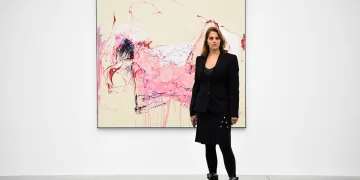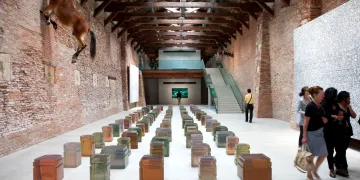Delve into London’s rich world of artists and discover the many great women who helped to shape the scene. Artists such as Bridget Riley, Tracey Emin and Rachel Whiteread have not just participated in the evolution of London's art; they have led it. Through their innovation and unique perspectives, these women have broadened the horizons of what art in London represents, pushing boundaries and challenging societal norms. As the Garrison Chapel played host to The Future Is Female, we examine the women who changed London’s art scene.
Historical Pioneers
Gwen John
Gwen John carved out a unique space in the early 20th-century art world with her introspective and intimate portraits. Her work, characterised by a subdued palette and contemplative mood, offered a stark contrast to the more boisterous and flamboyant styles of her contemporaries. Her art was a reflection of her quiet and reclusive nature, often depicting solitary female figures in simple domestic settings. The dedication to her craft and her refusal to conform to the artistic norms of her time have cemented her legacy as a pioneering figure in London’s art scene.
Dora Carrington
Dora Carrington, a member of the Bloomsbury Group, is celebrated for her versatile talent in painting, drawing and decorative arts. Despite her struggles with gender expectations and her tragic early death, Carrington's work has gained significant posthumous recognition. Her unique style, blending elements of post-impressionism and English pastoral, challenged the artistic conventions of her era. Carrington's art, often infused with a sense of melancholy and introspection, provides a poignant commentary on her internal world and the broader social context in which she lived.
Post War Artists
Bridget Riley
Bridget Riley is celebrated for her mesmerising optical illusions which helped to revolutionise perceptions of motion and colour within the art world. Her work is deeply rooted in the exploration of visual sensations, bringing about a dynamic energy to London's art scene. Riley's paintings invite viewers on a visual journey, challenging them to see beyond the surface and experience the fluidity of motion and the vibrancy of colour in new and profound ways.

Paula Rego
Bold narratives and powerful imagery have made Paula Rego a central figure in contemporary art. Her work often delves into themes of gender, identity and power, challenging the political and social landscapes of her time. Rego's distinctive style, which blends figuration with surreal and fantastical elements, has been instrumental in pushing the boundaries of narrative painting. Her impact on the London art scene is profound, inspiring a new generation of artists to tackle complex and often uncomfortable subjects with courage and conviction.
Contemporary Visionaries
Tracey Emin
Tracey Emin stands as a towering figure of unapologetic expression. Her often autobiographical art navigates through themes of love, loss and human fragility. It offers a raw and unfiltered glimpse into Emin’s soul. Her fearless exploration of personal experiences has forged a deep, resonant connection with audiences, making her one of the most influential contemporary artists in London and beyond.

Rachel Whiteread
Rachel Whiteread has a unique gift for transforming ordinary spaces into extraordinary art. By casting the negative spaces of everyday objects, Whiteread creates sculptures that speak volumes about presence and absence, memory and loss. Her work, including the iconic 'House' in East London, not only reshaped London's physical landscape but also its artistic imagination, challenging viewers to perceive the familiar in entirely new ways.

Emerging Talents
Lynette Yiadom-Boakye
Lynette Yiadom-Boakye is known for her innovative approach to portraiture and narrative painting. Her works, which often feature fictional characters rendered in a timeless style, challenge traditional representations of black subjects in art. Yiadom-Boakye’s paintings, characterised by their rich, textured surfaces and evocative compositions, have garnered critical acclaim. Her contributions to the London art scene highlight the importance of diverse voices and perspectives in contemporary art.
Helen Cammock
Helen Cammock’s interdisciplinary approach combines film, photography, print, text, and performance to explore social histories and narratives. Her work often focuses on themes of resistance, resilience, and the lived experiences of marginalised communities. Cammock's innovative use of various media has made her a significant emerging talent in London’s art scene. Her ability to weave complex stories and engage with historical and contemporary issues has earned her recognition and acclaim.
The legacy of these pioneering women extends far beyond their individual artworks. They have paved the way for future generations of female artists, empowering them to pursue their visions with boldness, authenticity and without fear.
The Future Is Female exhibition at Chelsea Barracks not only celebrated the contributions of some of the most exceptional female sculptors, but amplified their importance. The disparity of male to female voices in the art world is still significant but the contributions made by artists such as these have helped to reduce it.
Their contributions serve as a beacon, guiding and inspiring not just future generations of artists but all those who believe in the transformative power of art. In the ever-changing tapestry of London's cultural landscape, these women have engraved their names in bold strokes, reminding us that the future of art, much like its past, is indeed female.


